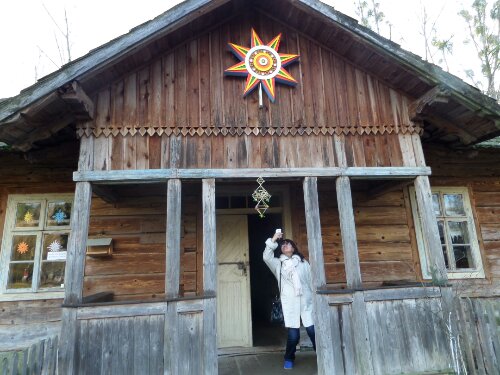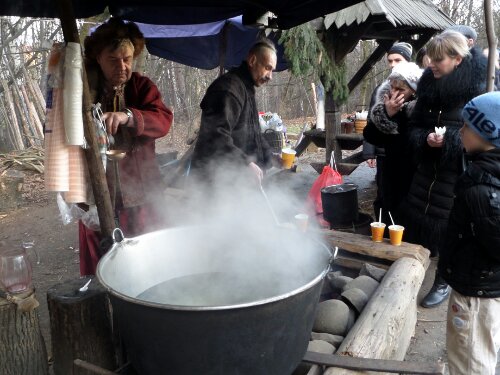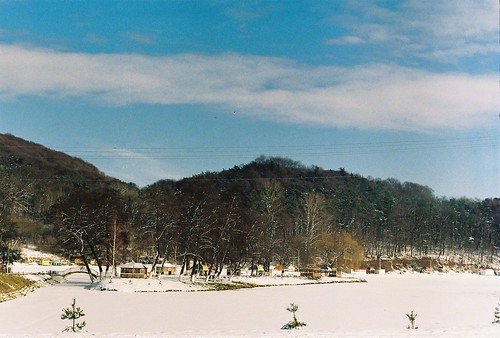Jag fick ett mejl från en student…
Category: by sophie engström, ukraina
Tags: Euromajdan, Hrusjevskij
…på facebook. Det är en bild på honom. Jag känner honom mycket väl. På fotografiet kikar hans ögon in i kameralinsen. Ögon som under min tid här i Lviv gått från lekfulla tonårsögon, till en ung vuxens förväntningar på framtiden. Jag tittar in i hans nu lite trötta ögon, ja, för ögonen är allt jag ser av hans ansikte. På huvudet bär han en hjälm. Över näsan och munnen har ha en mask. Han står mellan två kamrater. Jag känner inte igen dem, men det är ändå svårt att veta. De skyddande hjälmarna och maskerna är just i det här fallet till besvär. För mig.
På bilden står de på Hrusjevskijgatan. På den gatan där minst fyra demonstranter dödades på onsdagen. Bilden är tagen timmarna innan dödskjutningarna. De står på barrikaderna och omkring dem ser jag de kvarter jag lärt mig känna igen från bilder och “strömmar” på internet. Det kvarter som för evigt kommer vara märkt av det våld som förekommit där. Jag ser in i min students ögon, och ser samtidigt alla mina andra studenter. Jag ser att allt de önskar sig är en vettig tillvaro. En framtid utan förtryck och korruption. De vill inte leva i en diktatur, eller en semidiktatur som det är nu. De vill också kunna uttryck sig fritt. De vill inte behöva vara rädda för sin egen poliskår. En poliskår som just nu inte bara skjuter på unga män, utan även förnedrar och torterar demonstranter så fort de får möjlighet. (Nedan kan ni se en hemsk video hur kravallpolisen (Berkyt) förnedrar en naken demonstrant.)
Jag ser in i min students ögon och känner hur sviken han är. Hur besvikna han och hans kamrater är. Svikna av EU. Av USA. Av sitt eget lands ledare. Jag ser en generation som lärt sig drömma och tro på ett annat politiskt etablissemang och tror på en bättre och tryggare tillvaro. Jag ser en generation som Ukrainas president och premiärminister vill krossa. Jag ser en generation som kallas “terrorister” av den politiska eliten. Och inom mig växer det en vrede, en känsla av frustration och maktlöshet.
Jag ser in i min students ögon och tänker att “honom kallar de också fascist”. Inte bara terrorist. Jag vet vad han tänker. Varför gör vi inte mer? Men i mitt eget hemland har många beslutat sig för att demonstranterna i Kyjiv bara är fundamentalistiska fascister. Det är nog inte möjligt för oss i Sverige att förstå hur det är att vara förtryckt. Förtryckt av sina egna. Förtryckt av ett annat land. Jag vet att min student inte är någon fundamentalist, fascist eller rasist. Men jag vet att han är stolt över sin kultur, sitt språk, sitt folk. Han kallar sig säkert också patriot (även om jag inte hört just de orden från hans mun). Patriot i ett svenskt perspektiv… ja, det är väldigt svårt att förklara vår svenska position. Att varje gång vi hör det begreppet värjer vi oss.
Det är oerhört svårt att förklara att vi har svårt att se utanför vår egen kontext. Som alla andra tolkar vi det mest genom våra erfarenheter. Det blir därför svårt att förstå att man inte måste vara fascist för att känna en stor stolthet och en tror på sitt eget land…
Men i min students ögon ser jag också en annan framtid. En framtid där många av dessa unga kan radikaliseras. Inte för att de vill det själva. Utan för att landets ledning och vi, ja vi i trygga EU, faktiskt inte ger dem något alternativ.
Jag ser in i min students ögon och försöker ge honom och hela hans generation en styrka. En styrka att tro på sig själv och en styrka att aldrig ge upp. Jag hoppas att det kommer fram, att det via internets ettor och nollor faktiskt kommer fram.

Demonstranten på bilden har inget med min student att göra.
Bilden är tagen av Duncan Crawford, BBC korrespondent i Kyjiv.



























